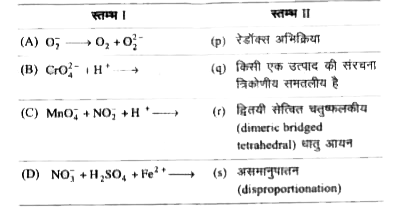एक जलीय विलयन में NO−3 आयन के अपचयन के लिए E∘ का मान + 0.96 V है | कुछ धातुओं के आयनों के E∘ नीचे दिए गए हैं
V2+(aq)+2e−→VE∘=−1.19VFe3+(aq)+3e−→FeE∘=−0.04VAu3+(aq)+3e−→AuE∘=+1.40VHg2+(aq)+2e−→HgE∘=+0.86V
जलीय विलयन में NO−3 द्वारा ऑक्सीकृत होने वाला/वाले धातु युग्म है (हैं)
V और Hg
Hg और Fe
Fe और Au
Fe और V
The correct Answer is:A, B, D
वे तत्व जिनके अपचयन विभव का मान NO−3(E∘=0.96V) की अपेक्षा अधिक ऋणात्मक होगा, NO−3 के द्वारा ऑक्सीकृत हो जायेंगे | V, Fe तथा Hg के अपचयन विभव का मान NO−3 की अपेक्षा अधिक ऋणात्मक है |
Topper's Solved these Questions
- रेडॉक्स अभिक्रियाएँ एवं विधुत रसायन BOOK - JEE Main & Advanced (Hindi Medium)CHAPTER - रेडॉक्स अभिक्रियाएँ एवं विधुत रसायन EXERCISE - रिक्त स्थानों की पूर्ति कीजिए
4 Videos
- रेडॉक्स अभिक्रियाएँ एवं विधुत रसायन BOOK - JEE Main & Advanced (Hindi Medium)CHAPTER - रेडॉक्स अभिक्रियाएँ एवं विधुत रसायन EXERCISE - सत्य/असत्य
1 Videos
- रेडॉक्स अभिक्रियाएँ एवं विधुत रसायन BOOK - JEE Main & Advanced (Hindi Medium)CHAPTER - रेडॉक्स अभिक्रियाएँ एवं विधुत रसायन EXERCISE - मैट्रिक्स-सुमेल प्रकार
3 Videos
- रासायनिक बलगतिकी BOOK - JEE Main & Advanced (Hindi Medium)CHAPTER - रासायनिक बलगतिकी EXERCISE - विश्लेषणात्मक प्रश्न
18 Videos
- विलयनBOOK - JEE Main & Advanced (Hindi Medium)CHAPTER - विलयनEXERCISE - (विश्लेषणात्मक प्रश्न)
11 Videos
Similar Questions
लोहे का यशदलेपन (galvanisation) ………………… के साथ लेपन (coating) को प्रदर्शित करता है |
View SolutionSTP पर, Mn+/M इलेक्ट्रोड के इलेक्ट्रोड विभाजन का सान्द्रता के साथ परिवर्तन निम्न व्यंजक के द्वारा दिया जाता है |
E=E∘+0.0591nlog10[Mn+]
View Solutionस्तम्भ I' में दी गयी अभिक्रियाओं का 'स्तम्भ II' में दी गयी उनकी प्रकृति/उत्पाद के प्रकार से मिलान कीजिए |

View Solutionएक प्रथम कोटि की अभिक्रिया 10 मिनट में 20% पूर्ण होती है। गणना कीजिए
(i) अभिक्रिया का विशिष्ट वेग स्थिरांक
(ii) अभिक्रिया के 75% पूर्ण होने में लगा समय।
View Solutionएथेनॉल तथा मेथेनॉल का वाष्प दाब क्रमश: 44.5 तथा 88.7 mm Hg है। समान तापक्रम पर 60 ग्राम एथेनॉल को, 40 ग्राम मेथेनॉल के साथ मिश्रित करके एक आदर्श विलयन बनाया जाता है। विलयन के कुल वाष्प दाब की तथा वाष्प में मेथेनॉल के मोल प्रभाज (mole fraction) की गणना कीजिए।
View SolutionFor the reduction of NOc−3 ion in an aqueous solution, Ec− is +0.96V, the values of Ec− for some metal ions are given below :
i.V2+(aq)+2e−→V, Ec−=−1.19V
ii.Fe3+(aq)+3e−→Fe, Ec−=−0.04V
iii.Au3+(aq)+3e−→Au, Ec−=+140V
iv.Hg2+(aq)+2e−→Hg, Ec−=+0.86V
The pair(s) of metals that is / are oxidized by NOc−3 in aqueous solution is / are
View SolutionBased on the data given below, the correct order of reducing power is: Fe_((aq.))^(3+) + e rarr Fe_((aq.))^(2+), E^(@) = +0.77 V Al_((aq.))^(3+) + 3e rarr Al_((s)), E^(@) = -1.66 V Br_(2(aq.)) + 2e rarr 2Br_((aq.))^(-), E^(@) = +1.08 V
View SolutionFor the reduction of NO_(3)^(-) ion in an aqueous solution E^(@) is +0.96V . Value of E^(@) for some metal ions are given below V^(2+)(aq)+2e^(-)rarrV E^(@)=-1.19V Fe^(3+)(aq)+3e^(-)rarrFe E^(@)=-0.04V Au^(3+)(aq)+3e^(-)rarrAu E^(@)=+1.40V Hg^(2+)(aq)+2e^(-)rarrHg E^(@)=+0.86V The pair(s) of metal that is/are oxidised by NO_(3)^(-) in aqueous solution is(arE):
View SolutionFor the reduction of NO_(3)^(-) ion in an aqueous solution, is +0.96V. Values of for some metal ions are given below : V^(2+)(aq)+ 2e^(-)rightarrowV , E^(@)= -1.19V Fe^(3+)(aq)+ 3e^(-) rightarrow Fe , E^(@) = -0.04 V Au^(3+)(aq) + 3e^(-) rightarrow Au , E^(@) = +1.40V Hg^(2+) (aq)+ 2e^(-) rightarrowHg , E^(@) = + 0.86 V The pair(s) of metals that is(are) oxidised by NO_(3)^(-) in aqueous solution is(are) :
View Solutionकुछ अर्द्ध-अभिक्रियाओं के इलेक्दोड विभव इस प्रकार हैं
Fe3+(aq)+e−→Fe2+(aq),E0=0.76V
Ce4+(aq)+e−→Ce3+(aq),E0=1.60V क्या Fe3+“से”Ce3+ ऑक्सीकृत होगा।
View SolutionFor the reduction of NO−3 ion in an aqueous solution, is +0.96V. Values of for some metal ions are given below :
V2+(aq)+2e−→V, E∘=−1.19V
Fe3+(aq)+3e−→Fe , E∘=−0.04V
Au3+(aq)+3e−→Au , E∘=+1.40V
Hg2+(aq)+2e−→Hg , E∘=+0.86V
The pair(s) of metals that is(are) oxidised by NO−3 in aqueous solution is(are) :
View SolutionStandard electrode potential data is given below : Fe^(3+) (aq) + e ^(-) rarr Fe^(2+) (aq) , E^(o) = + 0.77 V Al^(3+) (aq) + 3e^(-) rarr Al (s) , E^(o) = - 1.66 V Br_(2) (aq) + 2e^(-) rarr 2Br^(-) (aq) , E^(o) = +1.08 V Based on the data given above, reducing power of Fe^(2+) Al and Br^(-) will increase in the order :
View SolutionStandard electrode potential data is given below :
Fe3+(aq)+e−→Fe2+(aq),Eo=+0.77V
Al3+(aq)+3e−→Al(s),Eo=−1.66V
Br2(aq)+2e−→2Br−(aq),Eo=+1.08V
Based on the data given above, reducing power of Fe2+ Al and Br− will increase in the order :
View SolutionFor the reduction of NO_(3)^(-) ion in an aqueous solution , E^(0) is + 0.96 V , the values of E^(0) for some metal ions ar given below : i) V_((aq))^(+2) + 2e^(-) to V, E^(0) = 1.19V ii) Fe_((aq))^(+3) + 3e^(-) to Fe , E^(0) = -0.04 V iii) Au_((aq))^(+3) + 3e^(-) to Au , E^(0) = + 1.40 V iv) Hg_((aq))^(+2) + 2e^(-) to Hg , E^(0) = +0.86 V The pair(s) of metals that is/are oxidizd by NO_3^(-) in aqueous solution is /are
View SolutionBased on the data given below, the correcy order of reducing power is:
Fe3+(aq.)+e→Fe2+(aq.),E∘=+0.77V
Al3+(aq.)+3e→Al(s),E∘=−1.66V
Br2(aq.)+2e→2Br−(aq.),E∘=+1.08V
View Solution
